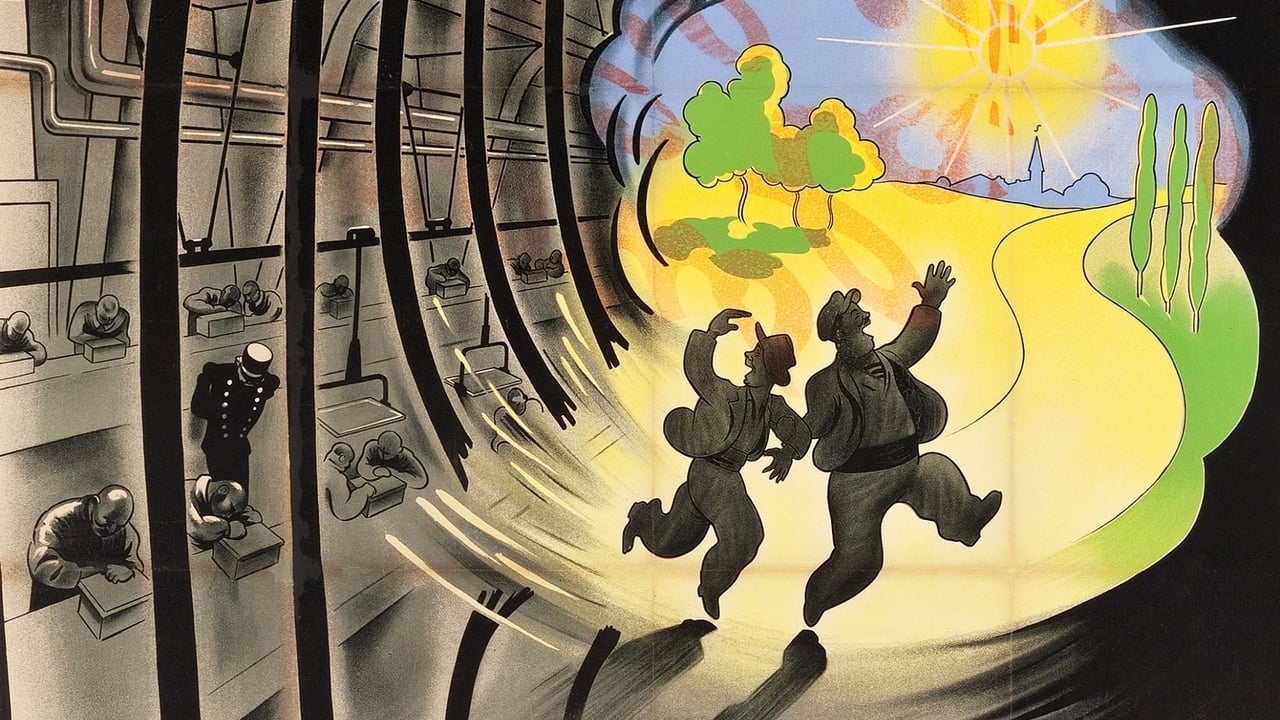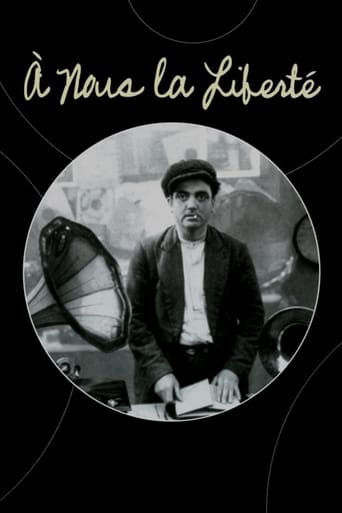Afouotos
Although it has its amusing moments, in eneral the plot does not convince.
Fairaher
The film makes a home in your brain and the only cure is to see it again.
Sarita Rafferty
There are moments that feel comical, some horrific, and some downright inspiring but the tonal shifts hardly matter as the end results come to a film that's perfect for this time.
treywillwest
It was striking watching this film shortly after having attended a very fine museum exhibit on American Precisionist painting, a style in vogue at the time this film was made. As in Precisionism, the imagery here is concerned with the industrialization of society. Every facet of social life, not just the work-place, but the school and the prison-system seems to director Rene Clair to have been turned into a factory. The film features some extremely clever editing making the connection between industrial production and the production of passive subjects of capitalism clear.
The difference between Clair and the Precisionists is that most of the latter saw in industrialization a utopian promise. What few who didn't, such as George Ault , understood industrialization in apocalyptic terms. In either case, it represented for the Precisionists an absolute transformation of life from which there was no turning back.
For the filmmaker's part, Clair clearly understood modernity in sinister terms, industrialization bringing about the mechanization of the subject, but his humanism made it impossible for him to see the modernist challenge to humanity as insurmountable. For Clair, human dignity could be salvaged just by forsaking the materialist temptations of capitalism for the simple pleasures of life. Exploiter and exploited could return to a loving, communal relationship by embracing poverty and freedom.
Art historians have proposed that the utopianism of Precisionist art was abolished by the horrific realizations of WWII. That would, it seems to me, to apply equally to the humanist utopia of Clair's cinema.
TallPineTree
I wanted to like this movie more, especially knowing the movie's history and theme, but in the end I was often bored and frustrated. When compared to Chaplin's "Modern Times", even though it was made after this movie and apparently heavily influenced by this movie, I would say "Modern Times" is a better movie.I was bored in part because the rhythm of many 1930s movies have a slower pace. Scenes go on long to ensure the 1930s audiences gets the point, but modern audiences are quick to catch on. Even allowing for, and expecting, a slower pace I was annoyed at times by the movie's pace.I was frustrated with the lead character. He didn't stand out in a good way. While he was suppose to be a simple everyday guy the audience is to identify with, he seemed dumb, dim witted, and oblivious when it came to the woman he was infatuated with. I realize it was a movie style back then, but it grates if the actor doesn't have the charisma to pull this act off. It also doesn't help when this movie doesn't have a character say the few words that would clear up the confusion.I liked the sets - they were typical 1930s art deco. Big rooms, tall doors, and clean lines. Even though it was obvious and heavy handed, I was fine with the theme that industrial work is like prison labor, while the guards and professors proclaimed that work means liberty.This is shown by the following scene: Factory guards discover one of the escaped convicts lying in the grass outside the factory enjoying the day, and one guard says: "Not at work?! Don't you know that ...". Then the scene cuts to a classroom where a bearded professor tells his class: "Work is mandatory. Because work means liberty." The young children at their desks and writing in their notebooks then sing what the professor just told them.
T Y
It's taken me a while to get to this.In appraising an old movie, there is entertainment and there are the ideas preserved in it. This movie may entertain some but more than likely a modern viewer will find the entertainment aspect lacking, and the movie a bit slow-moving; much like Metropolis, Nosferatu, The Cabinet of Dr. Caligari. Silent movies just proceed at a different pace which I find to be on the irksome side. You'll be predicting the movies plot points before they arrive. Its reputation as a comedy bewilders me, or at least its reception as one (in the modern era) does. It's value as a product to move ideas is intact. The socialism guiding every frame makes its points clearly and explicitly. Really... you're not going to miss the point. And the movie adopts various structural mirroring devices that are on the hoary side.Time is not kind to certain projects. I found myself begging for the long middle portion to speed up or be over with quickly. I felt this was a very average quasi-silent movie that is in our hands today because the production design was a little more novel than most. We just love superficialities like that here in the modern world. (See Blade Runner and it's 387 special editions). I say quasi-silent because the sound appears in concentrated, intermittent segments.
puzzow
I profess-- I never heard of this movie nor this director till I watched it tonight. As pointed out, the film has a socialist message-- mainly a scaffolding to hang some very clever physical humor on, though it manages to fit in a few astute (likewise hysterical) observations about modern industrial society. The male leads are absolutely charming and have great chemistry. The style of the film is something in itself. The soundtrack (one of the first original ones to be used in a film) is intertwined with the action on screen, and occasionally the actors sing along with it almost as if this were a musical...but not quite. There are moments of pantomime infused with talking scenes, almost as if the director was trying figure out how to work his style for making silent films into talkies. In total, it's a bit odd-- but it works! And it's unique. And far from dated-- it gave me quite a few belly-laughs.

